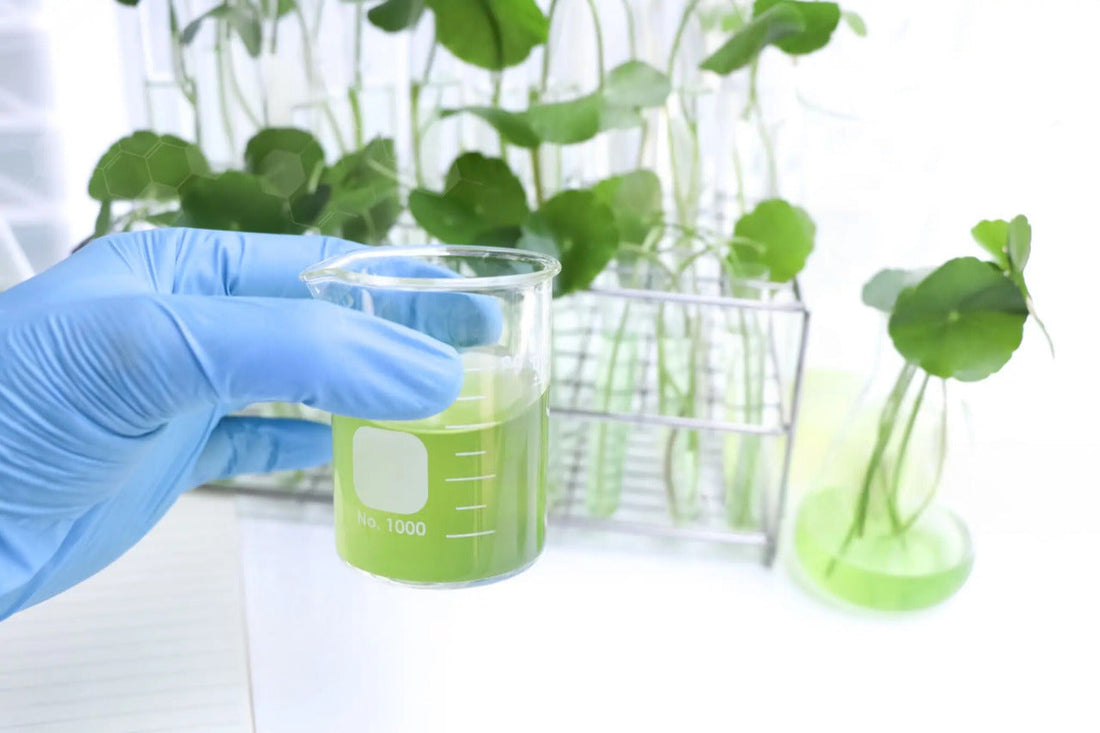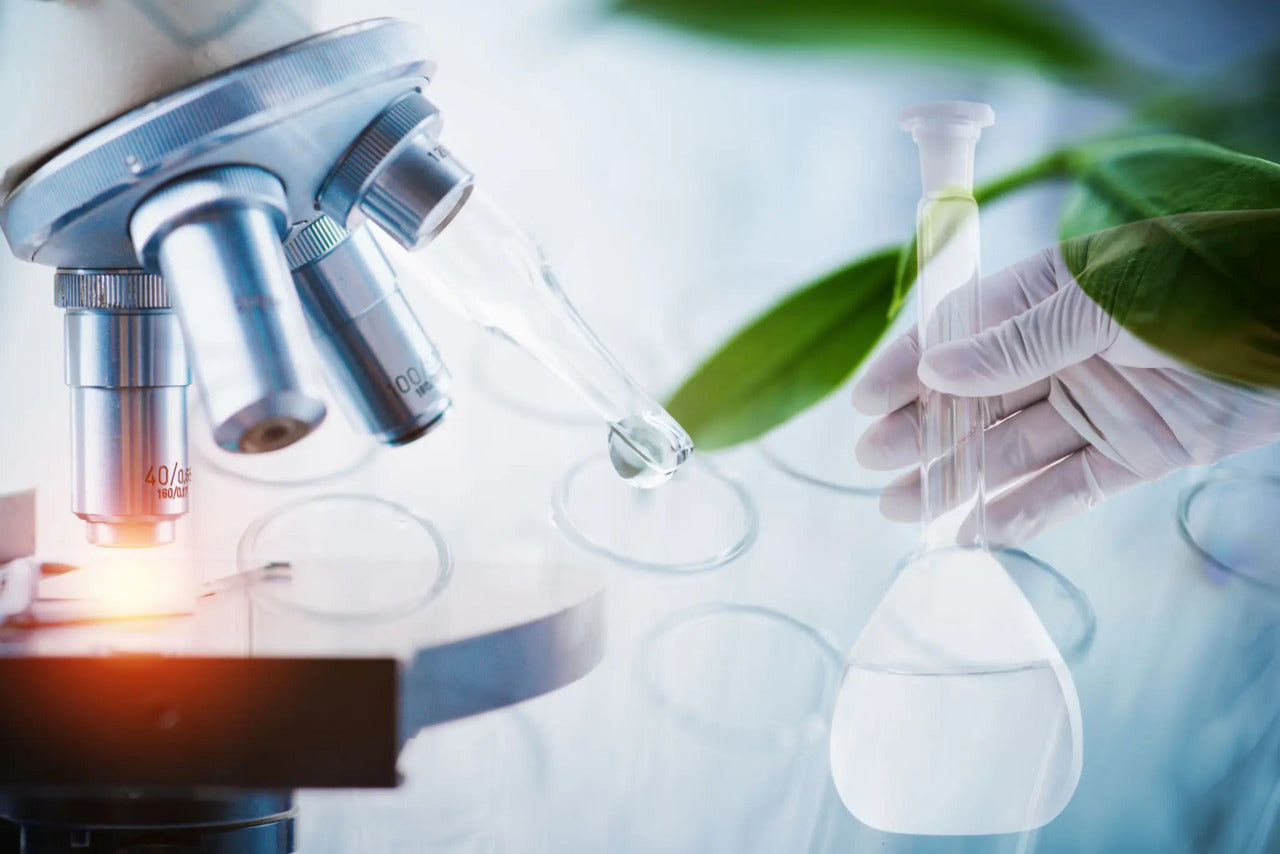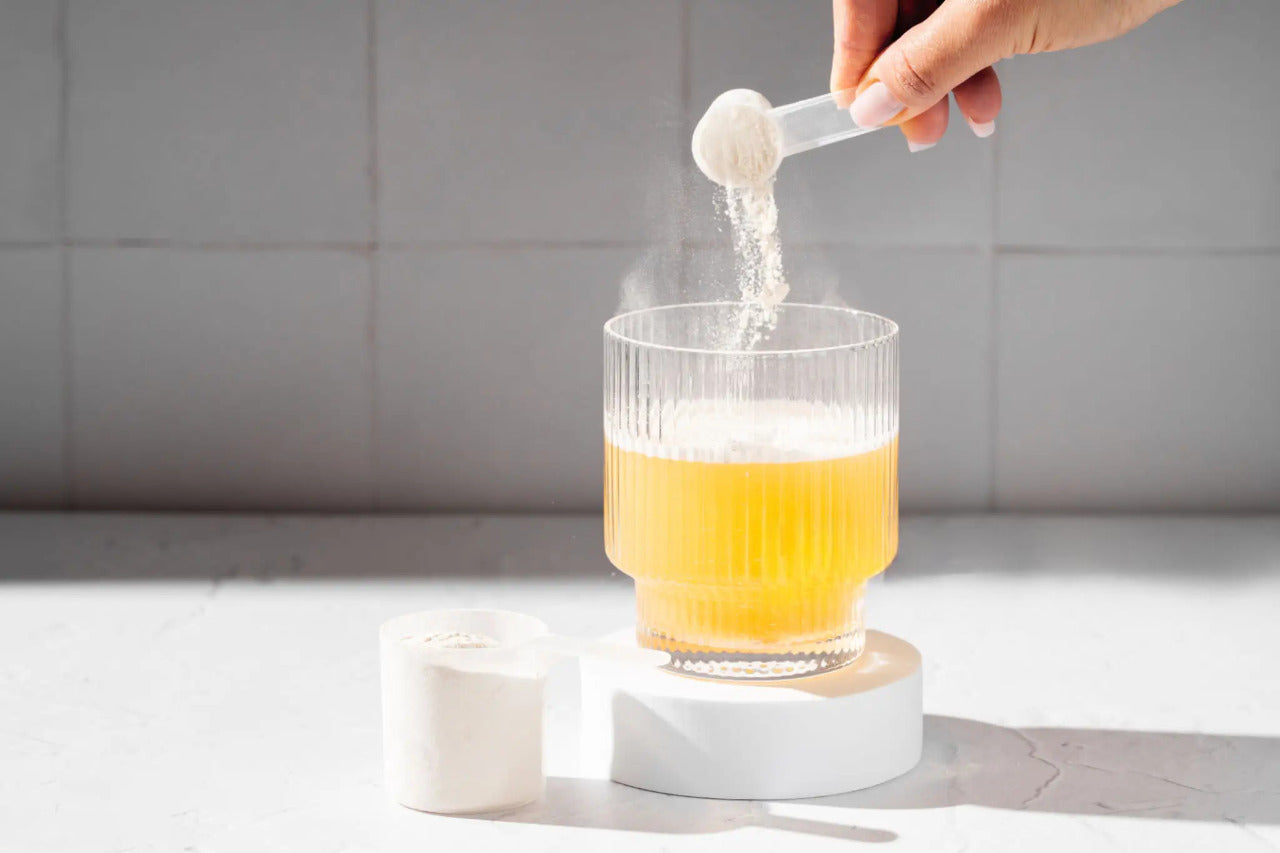
Biotechnologically Produced Collagen: Future or Hype?
Share
What is biotechnologically produced collagen?
You might be wondering: What exactly is behind the term "biotechnologically produced collagen"? Simply put: It's collagen that is not extracted from animal hides or fish carcasses, but is produced in the laboratory using microorganisms or synthetic processes. This alternative to traditional animal collagen offers you many advantages – especially if sustainability, purity, and animal welfare are important to you.
Fermentation versus synthetic methods
In the fermentative approach, researchers use bacteria or yeasts (such as Pichia pastoris) into which genetic material for human collagen is introduced. These microorganisms then produce collagen molecules in bioreactors.¹ The synthetic method, on the other hand, uses modern protein biosynthesis technologies to specifically assemble and refine collagen in cells.²
Microorganisms and plants as collagen producers
Studies have shown that yeast systems like Pichia pastoris can produce up to 508 mg/L of recombinant collagen when fermentation conditions such as methanol supply, pH, and temperature are optimized.³ Genetically modified bacteria such as E. coli have also been successfully used to produce stable collagen types without animal origin.⁴
Biosynthesis through genetic engineering – HumaColl21 example
A particularly exciting example is HumaColl21: This is fermentatively produced, human-like collagen based on modern design biology approaches. Initial reports show that these products have excellent biocompatibility and offer significantly less risk for allergic reactions or animal pathogens.⁵

Overview: Production methods
Fermentative production
In the fermentative approach, collagen is produced using microorganisms such as yeasts or bacteria – as in the case of HumaColl21. These microorganisms are genetically modified to produce human-like collagen. In one study, impressive yields of 2.33 g/L of human-like collagen were achieved in fermenters with Pichia pastoris, compared to only about 100 mg/L in shake flasks⁶. Even more impressive: In a multicopy strain of P. pastoris, collagen-like gelatin was released up to 14.8 g/L⁷. Bacteria can also replace traditional animal collagen: recombinant collagen fragments produced in E. coli reached 17.1 g/L⁸. These fermentative methods thus demonstrate high scalability and purity – completely without animal raw materials.
Synthetic biology & genetic engineering methods
In synthetic biology, collagen is specifically redesigned at the protein level. A promising strategy is the co-expression of collagen and prolyl hydroxylase in E. coli, which produced about 90 mg/L of hydroxylated human collagen with 25% proline hydroxylation – similar to natural collagen⁹. This hydroxylation is crucial for the stability of the triple-helix structure. Such genetically optimized systems show that synthetic collagen functionally and structurally comes very close to natural collagen, even though yields are still below those of fermentative methods.
Bioreactor processes & quality assurance
Modern bioreactors enable precise control of parameters such as pH, temperature, and nutrients. This improves yield and ensures consistent quality. Important control points are:
✅ The content of hydroxyproline (more stable collagen structure)
✅ The stability of the triple helix (e.g., tested by pepsin resistance)
✅ Purity regarding endotoxins and contaminants
This creates reliable laboratory collagen with clear quality standards – perfect for various applications in cosmetics, medicine, or dietary supplements.
If you are also looking for laboratory-tested collagen that has 100% purity, then you are in the right place at Kollagen Institut.
Comparison: Biotechnologically produced vs. animal collagen

Origin and purity
Do you want a pure, safe product? Biotechnologically produced collagen, obtained from yeast, bacteria, or plants, offers you exactly that – completely without animal origin. Studies show that marine fish collagen causes far fewer immunogenic reactions than bovine collagen¹⁰. An in vitro study with mesenchymal stem cells even demonstrated that fish collagen offers comparable cell compatibility and differentiation to mammalian collagen¹¹. Animal collagens, on the other hand, carry risks such as allergies, batch variations, and possible pathogens¹². With biotechnologically produced collagen, these concerns are completely eliminated.
Biocompatibility & bioavailability
Biotechnologically produced collagen scores with structurally accurate composition and high bioavailability. Through targeted genetic engineering processes, you get collagen molecules that are very similar to human collagen – ideal for skin, joints, or tissue repair. Marine collagen also scores with high absorption capacity in the body¹³. In comparison, animal collagen shows greater variability in molecular size and purity.
Sustainability & ethics
Do you value sustainability and animal welfare? Then biotechnologically produced collagen is the resource-saving choice: It needs no animals, saves land, water, and reduces CO₂ emissions – and can be scaled long-term¹². Fish collagen from by-products of the food industry already helps, but it remains animal-based. Biotechnological collagen alternatives offer a real, animal-testing-free alternative.
If you are looking for vegetarian collagen or vegan collagen to significantly boost your body's own collagen production, then take a look at Kollagen Institut. Here you get maximum bioavailability at an unbeatable price-performance ratio.
Opportunities and challenges
Viable application scenarios and markets
Biotechnologically produced collagen opens up exciting possibilities in various areas. In the cosmetics industry, collagen is increasingly used in skincare products to improve skin elasticity and reduce signs of skin aging. Studies have shown that collagen peptides can promote collagen synthesis in the skin¹⁴. In nutrition, collagen products are found in dietary supplements and functional foods intended to support joint health and skin structure. Furthermore, collagen is used in regenerative medicine as a biomaterial for wound healing and tissue replacement¹⁵.
Technical & regulatory hurdles
Despite the potential, there are challenges in the production and approval of biotechnologically produced collagen. Quality assurance and standardization are crucial to ensure consistent products. Approval by regulatory authorities such as the FDA and EMA requires extensive clinical data and compliance with strict guidelines. Additionally, high production costs and limited infrastructure can complicate the scaling of production. The acceptance of such products by consumers and professionals is also an important factor for success¹⁶.
Future perspectives
The future of biotechnologically produced collagen looks promising. With advancing research and development, tailor-made collagen products could emerge that address specific therapeutic or cosmetic needs. The integration of collagen into mainstream products could be driven by innovative technologies such as 3D printing and personalized medicine¹⁷. Combined strategies, such as the development of designer collagen and customized peptides, could open up new application fields and further increase the effectiveness of therapies and cosmetics.
 Conclusion: Biotechnologically produced collagen – opportunities, challenges, and outlook
Conclusion: Biotechnologically produced collagen – opportunities, challenges, and outlook
Biotechnologically produced collagen stands on the threshold of shaping the future of regenerative medicine, cosmetics, and nutrition. By using microorganisms such as yeasts, bacteria, or plants, it becomes possible to produce collagen in high purity and without animal origin. This not only reduces ethical concerns but also risks regarding immune reactions and pathogens.
The application areas are diverse: In the cosmetics industry, collagen is used to improve skin elasticity and reduce signs of skin aging. In nutrition, collagen products are found in dietary supplements and functional foods intended to support joint health and skin structure. Furthermore, collagen is used in regenerative medicine as a biomaterial for wound healing and tissue replacement.
Nevertheless, there are challenges: Production costs are currently still higher than for animal collagen, and the scalability of production must be further improved. Additionally, strict regulatory requirements must be met to ensure the safety and efficacy of the products.
Despite these hurdles, research shows promising progress. New technologies such as designer collagen and customized peptides open up additional application possibilities. With advancing development and increasing acceptance, biotechnologically produced collagen products could play a significant role in the health and beauty industry in the near future.
References
-
Guo, X. et al. Fermentation of recombinant collagen in Pichia pastoris achieved 508 mg/L output under optimized conditions.
-
Peng, Y. et al. Microbial fermentation produces recombinant collagen-like proteins with stable structures. Collagen Science Update, 2024.
-
Zhang, L. et al. Optimization of medium components enhances collagen production in Pichia pastoris. 2023.
-
Añazco, P. et al. E. coli-based fermentation yields higher collagen production than mammalian systems. Collagen Science Update, 2024.
-
Evonik/Cambrium studies (2023): First biocompatibility trials of HumaColl21 show low immunogenicity and high purity. MDPI Biocompatibility Review
-
Expression of recombinant human-like collagen in Pichia pastoris reached 2.33 g/L in 5-L bioreactor. Bioresources and Bioprocessing (2022)
-
Pichia pastoris multicopy strains produce up to 14.8 g/L recombinant gelatin. High-yield secretion of recombinant gelatins (1999)
-
Production of 17.1 g/L recombinant collagen in E. coli. Towards scalable production of a collagen-like protein from Streptococcus pyogenes (2012)
-
Hydroxylated human collagen (25% hydroxylation) with 90 mg/L yield in E. coli. Recombinant expression of hydroxylated human collagen (2013)
-
Sotelo, C.G. et al. "Study of the immunologic response of marine-derived collagen and gelatin extracts." Scientific Reports, 2021.
-
Rusinek, K. et al. "Biocompatibility of fish skin collagen with mesenchymal stem cells." SAGE Journals, 2023.
-
Innovation reviews on marine vs animal collagen: immunogenicity, zoonosis, sustainability. PMC, 2020.
-
Xu, S. et al. "Improving the Sustainability of Processing By-Products… Collagen Peptides." Foods, 2023.
-
Collagen peptides affect collagen synthesis and the expression of COL1A1, ELN, and VCAN genes in dermal fibroblasts.
-
Advances in regenerative medicine-based approaches for skin tissue engineering.
-
Comparative Analysis of EMA and FDA Regulations in the Biotech Industry.
-
Advancements in Clinical Utilization of Recombinant Human Collagen.
Image credits
Kittisak Kaewchalun, Anawat_s, Gingagi, MARHARYTA MARKO from istockphoto.com
